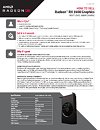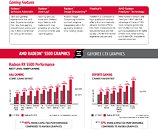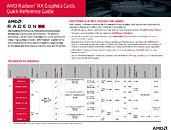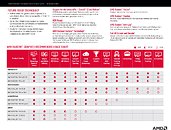Friday, November 8th 2019

AMD Radeon RX 5500 Marketing Sheets Reveal a bit More About the Card
Marketing material of AMD's upcoming Radeon RX 5500 mid-range graphics cards leaked to the web, providing insights to the product's positioning in AMD's stack. The October 2019 dated document lists out the card's specification, performance relative to a competing NVIDIA product, and a provides a general guidance on what experience to expect form it. To begin with, the RX 5500 desktop graphics card is based on the 7 nm "Navi 14" silicon, and is configured with 22 RDNA compute units, amounting to 1,408 stream processors. The chip features a 128-bit wide GDDR6 memory bus, which is paired with either 4 GB or 8 GB of memory running at 14 Gbps data-rate, yielding 224 GB/s of memory bandwidth. Its GPU clocks are listed as 1670 MHz "gaming," and 1845 MHz boost. The company didn't mention nominal clocks. The typical board power is rated at 110 W, and a single 8-pin PCIe power input is deployed on the reference-design board.
The second slide is where things get very interesting. AMD tabled its product stack, and the RX 570, RX 580, and RX 590 are missing, even as the RX 560 isn't. This is probably a sign of AMD phasing out the Polaris-based 1080p cards in the very near future, and replacing them with the RX 5500, and possibly a better endowed "RX 5500 XT," if rumors of the "Navi 14" featuring more CUs are to be believed. What is surprising about this whole presentation though is that only the "RX 5500" is listed, with the "XT" nowhere in sight. Let's hope the XT version gets released further down the road. In the product stack, the RX 5500 is interestingly still being compared to the GeForce GTX 1650, with no mention of the GTX 1660. This document was probably made when the GTX 1660 Super hadn't launched. A different slide provides some guidance on what kind of experiences to expect from the various cards, rated N/A, good, better, or excellent. According to it, the RX 5500 should provide "excellent" AAA gaming at 1080p, fairly smooth gaming at high settings (graded "better"), "excellent" e-Sports gaming, and "better" 1440p gaming. The card is also "excellent" at all non-gaming graphics, such as watching 4K video, photo/video creator work, game streaming at any resolution, and general desktop use.
Source:
juggies (Reddit)
The second slide is where things get very interesting. AMD tabled its product stack, and the RX 570, RX 580, and RX 590 are missing, even as the RX 560 isn't. This is probably a sign of AMD phasing out the Polaris-based 1080p cards in the very near future, and replacing them with the RX 5500, and possibly a better endowed "RX 5500 XT," if rumors of the "Navi 14" featuring more CUs are to be believed. What is surprising about this whole presentation though is that only the "RX 5500" is listed, with the "XT" nowhere in sight. Let's hope the XT version gets released further down the road. In the product stack, the RX 5500 is interestingly still being compared to the GeForce GTX 1650, with no mention of the GTX 1660. This document was probably made when the GTX 1660 Super hadn't launched. A different slide provides some guidance on what kind of experiences to expect from the various cards, rated N/A, good, better, or excellent. According to it, the RX 5500 should provide "excellent" AAA gaming at 1080p, fairly smooth gaming at high settings (graded "better"), "excellent" e-Sports gaming, and "better" 1440p gaming. The card is also "excellent" at all non-gaming graphics, such as watching 4K video, photo/video creator work, game streaming at any resolution, and general desktop use.




66 Comments on AMD Radeon RX 5500 Marketing Sheets Reveal a bit More About the Card
Some games:
Call of Duty Modern Warfare 2019
Witcher 3
Control
AC Odyssey
Far Cry 5
I think that AMD overrate the RX 5500M. Also This Laptop has R7 3750H which is not as fast as i5 9300h(r7 3750h is equal with i7 7700hq). Thus, R7 3750H bottlenecks with RX 5500M in some games such as AC Odyssey. Meanwhile GTX 1650 Laptop is more powerfull than GTX 1650 Desktop in some games because of the fact that Laptop version has 1024 cores. AMD said their RX 5500M pair with 32GB RAM in their benchmarks but GTX 1650 Laptop's RAM is 8GB and their CPU is R7 3750H.
I think that RX 5500 will be same with RX 580-590 and RX 5500 XT will be same with RX 590 8GB.
Base on AMD:
5500M have 22CUs, 1448 MHz Game Frequency, 1645 MHz Boost Frequency, 4GB GDDR6 128bit
5500 have 22CUs, 1670 MHz Game Frequency, 1845 MHz Boost Frequency, 4GB GDDR6 128bit
5500 Series have 22CUs, 1,717 MHz Game Frequency, 1845 MHz Boost Frequency, 8GB GDDR6 128bit
I aspect that what AMD mean 5500 Series actually the XT model because we know that AMD already give 5500 spec only have 4GB. "Coreteks" youtuber said AMD plan to release this 5500XT for $240 meanwhile the non XT ~$150.
In my opinion if the prices XT was "true", that prices simply overprices for very minimal difference between XT and non-XT
Source:
Reference 5500 Desktop: www.amd.com/en/products/graphics/amd-radeon-rx-5500
Reference 5500 Series: www.amd.com/en/press-releases/2019-10-07-amd-introduces-radeon-rx-5500-series-graphics-superior-visual-fidelity
Coreteks:
Given that AMD confirmed directly that the 22 CU OEM card is a cut-down part, there's no reason to expect a consumer XT card to have 22 CUs. And a $100 price jump for a slight overclock and some extra VRAM is idiotic. That itself should be reason enough to not listen to silly speculation off YouTube.
We also have leak 5 navi 14 chip leak with clock speed. It turn out that 5500 Series with 1,717 MHz Game Frequency is Navi 14 XTR meanwhile 5500 with 1670 MHz Game Frequency already using navi 14 XT chip. So for an XT and XTR chip but cut down GPU? That very weird already or maybe AMD plan the 5500 series was cut down like RX 460 that full chip arrive later in RX 560. I not really sure, I just try speculate thing base on what already leak
Navi 14 leak: videocardz.com/82538/five-variants-of-amds-navi-14-gpu-spotted
For what it's worth this strategy saved their asses in the past. The so called "Small-Die" era of TeraScale where they made extremely competitive mid-range cards in massive quantity for the average consumer instead of focusing efforts into flagships. The reduced unit cost also allowed them to pack newer tech into their cards, advance API feature support, and leverage OEMs with better pricing.
B) Saying "AMD plan to" is a statement of fact, which is not how one should speak of rumored/unsubstantiated information. Prefacing with "According to the leak, AMD plans to" is of course something else entirely. But the explicit statement of the information being uncorroborsted and unofficial is of paramount importance.
C) What on earth is a "plan price"? The point of a plan is to make it happen. You don't plan pricing that you aren't aiming to make real. And nobody at AMD is dumb enough to think they can sell a card 5-10% slower than the 1660 for $20-30 more.
D) Again, leaked specs - even hardware IDs and other info from drivers - rarely paint the full picture. Information found like this might be placeholders, preliminary, incomplete or just plain wrong. Will there be five Navi 14 SKUs out there? Undoubtedly, and likely more. OEM 5500 series is 1-2 (high and low clock bins, for example), then there's a 5500 and a 5500 XT for retail, then there's mobile - that's five already - and then there's likely at least one Pro version. It's quite likely Apple will want two Navi 14 SKUs for their laptops too, which are normally separate from non-Mac Radeon Pro cards. It's not unlikely we'll see a further cut-down variant for a 5400 or 5300 card either.
Speculation is fine and good, but it needs to be tempered by realistic outlooks (such as not believing they would charge $240 for an overclocked version of a $150 GPU) and a smidgen of caution. Of course I might be wrong and that random Youtuber might be right, but I'd rather be cautious and wrong than make stupid speculations.That's true, but it wouldn't be very expensive developing a 64-ish CU bigger sibling to Navi 10 - just scale everything up including the memory interface. It would still be a relatively small die (less than 400mm2) and lowering clocks would keep it within reasonable power limits. This would still of course cost quite a few million dollars to develop, test, tape out and make, but the $6-700 GPU market these days is more than big enough to justify that as long as the card is competitive. Which the 5700 series has demonstrated that it would be. I'm still hoping that "big" Navi 23 rumors with some form of RT are accurate though.
I see no one saying 1660 Super is loosing to RX 5700??
When objects are no longer needed they're deleted from memory, that's all there is to it.
But yeah... I don't really think it is as high as 150W, sounds more like a some arbitrary number drawn from hat.
And i kinda doubt an 5500 XT will beat a Fury X
Its action/reaction and the bottom line still stands, if AMD had been making actual progress beyond Vega we would have seen a different landscape. Right now we're stuck at 1080ti performance for nearly 3 years, and the only real alternative is a ridiculously overpriced product. And note; prior to the Navi 5700XT and Nv SUPER line there wasn't even a price change to that sub-top perf level.
The idea that AMD has (made) some sort of choice is wrong. AMD has no other option but to trail behind and has completely dropped leadership of ANY segment. Being value king isn't an achievement either, its a sign the product portfolio has no USPs.
It does NOT make more sense in a GPU market to focus entirely on midrange. Tomorrow's midrange is today's high end, and missing it as a high end product means missing the opportunity to milk it for good margins and then re-use it. AMD has missed that chance with Polaris, Vega and with Radeon VII, and Navi is a similar thing because its also way too late.
That improvement with lower specs comes with the change to DLNA achitecture, the change to 7nm or both?So if you cant compare CU's, TFLOP's, TDP's there are no way to compare based on the specs, how can we know if it is an entry level or a enthusiast card?
RTX 2070S(9620,48 GFLops) = 1.088*RX 5700xt(9661,44 GFlops), RTX 2070(8580,096 GFlops) = 1.12 RX 5700(7704,58 GFlops)
So assuming that RX 5500 has the same actual gaming clocks as gtx1660/S by TFlops alone coefficient will be something like 1.09. But RX 5500(224GB/s) has more memory bandwidth than 1660(192GB/s), but less memory bandwidth than 1660S(336GB/s), so one cannot really get the coefficient before equaling memory bandwidth. @W1zzard could run 1080p tests with vanilla 1660 gddr5 OC 2333MHz, thus 4*2.333*192/8 = 224GB/s to equaling RX 5500 memory bandwidth. But that would take too much work for proving very little.